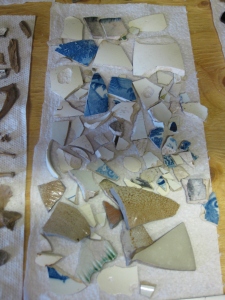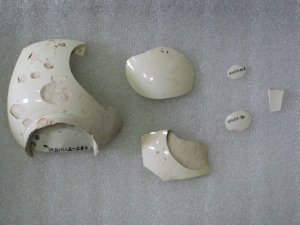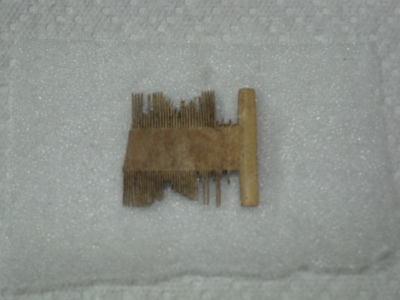Today’s post is by Danielle Rundquist, our Laboratory Supervisor. Danielle is a conservator, and her post today provides interesting insight into the complexities of archaeological conservation.
One of the common objects that we deal with in the lab is ceramics. Ceramic objects are as varied as the cultures that produced them, in terms of how they were made, their composition, style and use. Generally they have a clay body, often with a glaze applied to the surface. The body or fabric consists of clay minerals, temper and impurities.

Ceramics drying in the lab after being cleaned.
The North Range Barracks site is producing vast numbers of ceramic shards. Though no complete vessels have been found, the ceramics being excavated from the barracks are relatively stable with a variety of ceramic types, such as creamware, whiteware, and lusterware being unearthed.
In the conservation lab our first goal with a ceramic piece is to get it clean. This is done through aqueous cleaning with a soft bristle brush. Once cleaned, the pieces are laid out for a number of days to air dry.
Unlike cleaning of other materials, such as iron, cleaning ceramics can be a particularly satisfying experience. With minimal effort a ceramic piece can get quite clean, revealing surface details and designs that were not visible upon excavation.
When ceramic pieces of the same vessel are found, it is sometimes possible to mend these matching pieces together in an attempt to reconstruct the original vessel. In the past week, the barracks site has produced a number of ceramic pieces that can be glued together.

Ceramic fragments before reconstruction.
One particularly outstanding ceramic piece is a creamware bowl. (Amanda notes: creamware is a type of ceramic produced between about 1760 and 1820).
Upon excavation, we believed that we had four pieces of the original vessel which were promising candidates for mending.
The following day as we cleaned our ceramic pieces, we found an additional two pieces that belonged to this vessel.
We then decided to attempt to mend these pieces together. The process of reconstruction can be time consuming. Before beginning the reconstruction, the pieces need to be cleaned, dried, and labeled. Then we need to map out how the pieces will be put together. This is done to avoid having a piece “locked out” of the reconstruction.

Creamware bowl after reconstruction.
Once we map out the order the pieces need to be put together we can begin the reconstruction. In the lab we used a solution of approximately 20% Elmer’s white glue in water to adhere the pieces in place. (B-72 is another commonly used adhesive).
When applying the glue to the edges of the ceramics, we need to be careful to apply enough glue to securely hold the pieces together while avoiding having excess adhesive spill over the repair edges when the pieces are fitted together.
When two pieces “lock” together, we aim to have a nearly invisible seam. When a good fit is achieved, a fingernail run over the repair edge will not hitch at any point along the crack. Once the repairs are made, the vessel is placed in a container of sand while the glue cures. The outcome of this procedure can be very rewarding.
Another common material that has been recovered from the excavations are bone and shell. Due to the surprisingly dry nature of the site, we have a large volume of bone and shell that are in extremely stable condition. A particularly wonderful bone object that has been found is a bone comb.

The bone comb, before cleaning.
Upon examination of the piece, I was concerned that the teeth of the comb, which appeared to be intact, were actually held together by the dirt and debris that encased the object. Cleaning of the comb was slow, beginning with gentle dry brushing.
As the cleaning progressed it was discovered that all but two of the comb teeth were intact. To remove more stubborn pieces of dirt, a cotton swab with water was used to loosen and remove these pieces of debris.
The comb is beautifully preserved, and is currently air drying. Air drying is an effective method for drying but the evaporation of water can create enormous stresses in the structure of a bone. Bone responds to changes in relative humidity by expanding and contracting to varying degrees in three different dimensions (longitudinal, radial, and tangential), making bone a high risk for cracking while drying. During the drying process the outer surfaces of bone tend to dry first and contract around the still damp, expanded interior. This can cause areas of the bone to shrink, crack, or warp.

The bone comb, after Danielle has very carefully cleaned it.
It is a concern with the comb that it will dry too quickly causing irreversible distortion. This issue is being dealt with by creating a micro environment where the comb can dry in a slow and controlled manner.
The comb has been covered with a polyethylene sheet to reduce the evaporation rate and slow down the drying process. We monitor the drying of the bone on a daily basis.
If drying appears to be happening too quickly we will increase the relative humidity. This can be accomplished by reducing the temperature, which would require us to place the object in a refrigerator or by increasing the relative humidity in the vicinity of the bone (we can do this by hanging wet cloths over the drying racks containing the bone or adding room humidifiers.)
Another issue with organic material, such as bone, is the formation of mould on the object. Again our bone is monitored daily for evidence of mould growth. If mould is found, it will be removed from the object and sprayed with a solution of 20% isopropyl alcohol in water.
Hopefully, with all our careful monitoring, this special object will hopefully continue to dry in a stable and well preserved manner.
—Danielle Rundquist (Staff; Lab Supervisor).
Awesome field school! You’re finding such a great range of artefacts at the site – lots of organics, too, and lucky to have a conservator running the on-site lab! Great job, everyone!
By: Lori on July 31, 2009
at 12:11 pm
[…] More here: News From the Lab « Archaeology at Signal Hill, Newfoundland, Canada […]
By: News From the Lab « Archaeology at Signal Hill, Newfoundland, Canada | Beauty of Ceramics on July 31, 2009
at 8:53 pm
I got home from the field today, gave myself a thorough aqueous cleaning (no help from a conservator), and enjoyed reading Danielle’s new post while sitting on the back deck with a glass of wine. On Tuesday we begin processing our Grand Pre artifacts in the Halifax lab. Hope we can have as much fun as you guys. Have a look at the Grand Pre archaeology WordPress blog. Cheers, Rob
By: Rob on July 31, 2009
at 11:28 pm